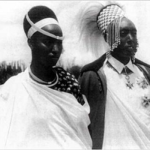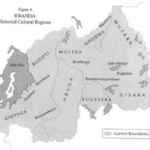The Accession of Musinga
In late 1896, Yuhi Musinga acceded to power as king of Rwanda. Located just south of the equator in central Africa, on the highlands that mark the geographic backbone of the African continent, this was a region of remarkable ecological diversity and therefore was home to a variety of occupational specializations: pastoralism in the open grasslands to the east; agriculture in the fertile highlands of the north. The center and the west; and hunting and trapping in the forests of the mountainous areas. But because Rwanda lacked certain key resources (iron and salt among them), a set of well-trafficked trade networks was also a part of the economic landscape, connecting various regions of Rwanda with neighboring societies. As a generally fertile and well-watered region this area had, over many centuries, attracted people from several physical stocks and different cultural backgrounds. From such ecological variety and such a diversity of immigrants, significant cultural and occupational differences had emerged in the region.
The expansion of the power of the royal Court brought with it a simplified set of social identities, recognizing essentially three ethnic categories within its domain:Tutsi, Hutu, and Twa. For the first European observers, too, such diversity begged for simple clarification, and they imposed their own conceptual apparatus, both within and beyond the domain of royal power. Late nineteenth century European intellectual frameworks posited race as the essential criterion by which social and physical diversity was categorized:Therefore, the diverse physical stocks and evident occupational differences in this region were conflated into the three categories recognized by the royal Court.These were then redefined as racial groups, with each corresponding to a single economic specialization and applied to the region as a whole: Hutu as agrarians (later estimated at about 85 percent of the population), Tutsi as pastoralists (about 14 percent), and Twa as hunters (about 1 percent). Complicated forms of personal identity and small-group mobility were represented within a simplified history of “ethnic migrations” in which these three groups, presumed to be of distinct racial stocks, were said to have entered the area in successive coherent “waves,” with Twa followed by Hutu followed by Tutsi, resulting in a clear ethnic/racial hierarchy. In this simplified vision, each succeeding group dominated its predecessor groups, resulting in a layered political and social hierarchy. Within this conceptual universe, earlier social identities and more precise histories were categorized as of atavistic, local interest only; such was the power of colonial hegemony that only “national” units were what counted.
That was the theory.Today we know that social mobility does not always occur as “migration.” Instead, mobility often takes the form of individuals or social groups moving incrementally. When carried out over centuries, such processes create complex cultural landscapes, such as those that mark this region. Furthermore, the definitive link between occupation and cultural identity is not always as clear as this conceptual image presumes. In Rwanda, cattle-keeping and farming were complementary, not exclusive, activities; the skills required for each are not held by one social group alone. Individuals and households could – and often did – simultaneously tend cattle, till the soil, and trap game.
Historically, however, this was an area where regional differences were significant, as were people’s loyalties to particular political authorities. Even at the time that Musinga acceded to power some of those local loyalties remained. Therefore, this geographically diverse region was also politically diverse, and for much of itshistory included several distinct dynastic units. Noretheless, over time one dynasty, associated with the Nyiginya clan identity, had come to dominate the politics of the region. That was Rwanda, the kingdom that Musinga would come to rule.
The Nyiginya state was the product of a long political history. Long before the emergence of the dynasty, large areas of forest had been cleared by early arrivals, leading to lineage claims to the land known as ubukonde. The association of land with a particular lineage meant that sometimes bakonde (those who held land rights) would accept clients on their land—often people who had fled from elsewhere (from drought conditions, land shortage, or political demands). But in many areas such local autonomy was disrupted by the political expansion of the kingdom. This was especiaily true from the mid-eighteenth century, when the Rwandan king Cyilima Rujugira, beset by serious military challenges, reorganized the military structures of the state, establishing permanent standing armies (ngabo) on its borders. From these ‘social armies,” which included many people attached to them as porters and as providers of food, there developed three attributes that characterized the Nyiginya kingdom. The first was the expansion of the state itself, as these armies allowed the Court to extend its influence to new areas. The second concerned institutional development. Stationed far from their home areas, these armies established an administrative presence of their own, requisitioning food, workers, and porters from the local population. This was the beginning of an administrative structure of a state based on more than simply military campaigns, for these army institutions came to define a clear hierarchy separating power holders (the ntore, or army personnel) from servants (bagaragu, or clients). These distinctions became the core of a culture of hierarchy that marked the army units and became pronounced at the Court.
With such self-conscious distinctions in place, the Nyiginya Court began to develop a strong sense of protocol, a status consciousness expressed through refined etiquette that was to mark the Court as separate from the society in an arena where class and status were very important. Setting off the Court elite from the society in general, these differences were reinforced by language styles, particular food types, forms of personal bearing, leisure activities, and individual ornamentation (including clothing and hairstyles, as well as particular types of bracelets and anklets). Along with this refinement of royal culture, the Court also developed its own ideology, one justifying the rule of the elite and expressed through a panoply of highly formalized rituals and a set of historical narratives explaining the origins of the dynasty. These elaborate ritual paradigms justifying royalty were the third attribute of Court development. By the early nineteenth century such features had become codified into a royal protocol known as the ubwiru, the ritual code governing various aspects of ritual and political practice and the legitimizing feature of royalty at the Nyiginya Court. The biru, those responsible for performing the rituals, had a privileged place at the Court.Thus, the development of particular forms of army organizations, administrative institutions, and ideologies served as the foundation of the emerging Nyiginya kingdom.
The continued expansion of the kingdom in the early nineteenth century brought new developments, as conquest also implicated administrative norms. In the central areas of the kingdom, by the early nineteenth century a series of overlapping authority structures had developed, which applied to lineage affiliation, to land, and to pasture (for cattle). For a given district, distinct delegated Court officials were assigned to each domain. Batware, originally army leaders, were increasingly assigned administrative powers over specific lineages, including military conscription and taxation (ikoro) in the form of cattle payments, agricultural produce, or luxury items such as mats of special reeds, woven fiber anklet/bracelets, or rare animal skins. Because an individual army chief could have several different assignments simultaneously (and because they were often reassigned), batware often exercised power through individual lineage networks in various regions. Other official delegates, called banyabutaka, were responsible for specific land grants (and the people living on them). Again, individuals at the Court could be assigned responsibility for multiple ibikingi domains to respond to specific demands for pasture. However, by the nineteenth century the kingdom had expanded—and so had the number of elite positions at the Court marked by possession of increasingly large cattle herds. In the early nineteenth century, during the reign of King Yuhi Gahindiro, the Court responded to specific requests for pasture by creating a new type of authority, exclusively responsible for pastureland. These delegates, banyamukenke, gradually extended their authority over cattle-holders. But they also served as a countervailing presence to batware and banyabutaka in any given region.
The result was the emergence of a complex administrative mosaic that ensured the Court bath bonding and flexibility. Such overlapping appointments established more complete Court authority over the people. With each delegated authority over-seeing the actions of his colleagues, they also prevented any one regional chief from accumulating power that in the end might challenge the power of the Court (and potentially might lead to secession). A complex political balancing act emerged at the Court, reinforced by a system of parallel channels of power among ambitious appointees.
Consequently, over the course of the nineteenth century the Court became increasingly important as the sole effective arena for political maneuvering. As Des Forges noted:”As the legitimacy of the Courts power grew… powerful men rarely opposed it openly but sought to control it from within.”Hence, the struggle for power and influence intensified at the Court, as illustrated in the manner of Musinga’s accession to power.
One of the ways such power was exerted was through kinship alliance, and so lineages became influential networks at the Court. In this patrilineal society, the royal lineage (the Bahindiro lineage of the Banyiginya clan) was one such channel. However, other lineages were important as well, and these manifested themselves in three principal roles: as artisan specialists responsible for producing particular items for the Court—Iron goods, ornaments, mats, or construction elements; as ritual specialists responsible for the well-being of the sovereign or the state; or as the lineages of the queen mother. In theory the royal heir was to be chosen from among the sons of a woman of a prescribed clan; the roleof queen mother was supposed to alternate in a regular cycle among four particular named clans. But in practice, politics over-came prescription. From among these four “matridynastic” clans, one, the Bega, came to play a dominant role in the succession; by the end of the nineteenth century, three of the last four kings had been born to Bega mothers. Furthermore, all three of those sovereigns had come to power before their maturity, giving the queen mothers significant influence over the affairs of the Court. Thus political maneuvering often came strongly into play in the succession process, with lineages fiercely competing over the role of queen mother.
Such competitive maneuvers were crucial to the accession of Musinga. Rutarindwa, Rwabugiri’s named successor and for ten years his “co-ruler,” was the son of a woman of one matridynastic clan, the Bakono. But she had died young (by Court execution), and so Rwabugiri had named another woman, Kanjogera, as Rutarindwa’s adoptive mother; she was expected to serve as queen mother on Rutarindwa’s accession to power. However, the newly designated queen-mother-in-waiting already had an infant son of her own, who was also eligible to succeed Rwabugiri. Therefore, it was she, along with two of her brothers in the Bakagara lineage of the Bega clan, who maneuvered to place the young Musinga in power. Having played a determinative role in the succession, these three actors—the mother and two maternal uncles of Musinga—remained extremely influential in the affairs of the Court well into Musinga’s reign; indeed much of this story details Musinga’s early subordination to them and his later struggle to free himself from the influence of these powerful personalities.
From the time of Rwabugiri, then, several conditions shaped the actions at the Court. One was the diversity of the society, including both the cultural variations on the ground and the high degree of social stratification that characterized Rwanda at the end of the nineteenth century.Another was the character of the Court, with its own formal etiquette and its own sometimes rapidly changing alliances. A third was the pervasive role of violence at the very core of Court culture at this time, as shown both in the Court’s relations with those outside the Court and in the activities among Court members: Rwabugiri himself, for example, had ordered the execution of his own mother, his biological father, and several of the most influential actors at the Court; in another case, the head of a powerful lineage killed his sister (who was also the wife of the king of the day) with his own hands; and whole lineages were sometimes wiped out in political pogroms.At the Court, politics mattered. Finally, it is important to recognize that the domain of the Courts influence varied over time, and these differences in the extent of Court influences were particularly marked between reigns. Many areas of what are now part of Rwanda had long been autonomous; indeed, some had actively resisted the extension of Court power into their domain, while others had a more ambiguous relationship to the Nyiginya state. In short, the current extent of the Rwandan state was defined in large part through the exercise of European power.
Rwabugiri combined an expansion of his authority outward with the intensification of his rule downward. Greater control at home enabled him to embark on military adventures abroad. Awarding prestigious combat assignments and distributing the fruits of victory allowed him to satisfy the ambitions of his notables, for military expeditions meant fame and renown in tins highly status-conscious culture. His military activities also took him too many regions of Rwanda. These travels helped consolidate Court rule in those areas, for as he traveled he was accompanied by the Court, its numerous courtiers, and several armies, all of which made demands on the local population. In addition, campaigns abroad often brought in large quantities of spoils, notably cattle-valued both in themselves and in their utility as gifts, since bestowing a cow on another could be seen as establishing a hierarchical relationship between the two parties. In short, Rwabugiri’s military campaigns served many purposes over and beyond simple conquest and extraction. Equally important, they led to honor and wealth for those at Court, and resources with which individuals could expand and reinforce their client networks,
However, although Rwabugiri was almost constantly engaged in such activities, many of the areas conquered during his reign were only ephemerally incorporated into Rwanda, On his death many such areas regained their autonomy; they were part of Rwanda only while force made it possible. Nonetheless Rwabugiri’s expeditions could have a significant effect on regional politics. In Kinyaga, in the southwest, and in some areas of the west of present-day Rwanda, for example, occupation by Court personnel was sufficiently enduring to establish a Court delegate as a powerful local presence, to restructure local client-ship relations, and to put in place administration structures that endured after the king’s death. But such areas were limited; following Rwabugiri’s death in 1895 many other areas reclaimed (or tried to reclaim) their independence from Rwanda. It was only with European arms, as the Germans sought to reinforce the Courts domains and extend the influence of the Nyiginya Court during Musinga’s reign, that many of these areas were reincorporated into Rwandan administrative structures. So the contours of Rwanda as we know it today are in many instances a modern creation, a product of Musinga’s reign, in winch Court agency was combined with the actions of missionaries and the power of the colonial administration. Under Musinga the state greatly expanded, as well as deepened.
https://uk.amateka.net/the-accession-of-musinga/https://uk.amateka.net/wp-content/uploads/2020/05/musinga.pnghttps://uk.amateka.net/wp-content/uploads/2020/05/musinga-150x150.pngHistory of kingsIn late 1896, Yuhi Musinga acceded to power as king of Rwanda. Located just south of the equator in central Africa, on the highlands that mark the geographic backbone of the African continent, this was a region of remarkable ecological diversity and therefore was home to a variety of...BarataBarata rpierre@ikaze.netAdministratorAMATEKA | HISTORY OF RWANDA




